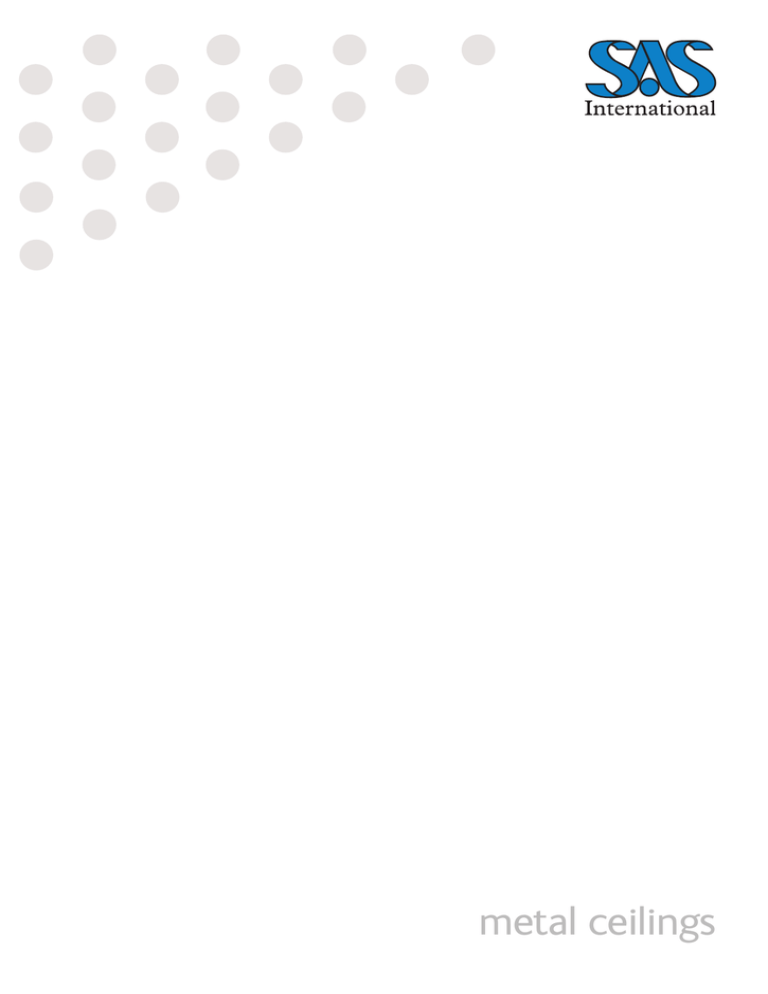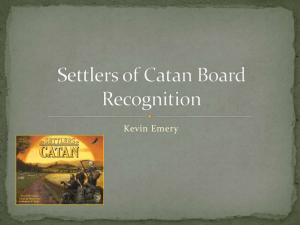
metal ceilings
system 330
lay-in tiles (c-profile suspension)
SAS International +44 (0) 118 929 0900 www.sasint.co.uk
System Description
SAS System 330, linear or tartan grid, is a lay-in tile
system that provides functionality and outstanding
performance with a range of cost effective design
options.
System 330 offers the facility to design the ceiling to any
building grid size. Tiles are available in a range of shapes
and sizes to meet individual project requirements.
System 330 ‘CoolCeil’ incorporates a Radiant Chilled
Ceiling element in the rear of the tile, further details are
available on page 173.
Supported from either an Omega C-Profile with a M6
thread form or a plain C-Profile. Both profiles can be
fitted with a gasket that provides a tight seal between
profile and tile.
System features:
• Infinite range of modules for any building module
• Flexible layouts for relocation of partitions
• Optional Radiant Chilled Ceiling solution
• Optional hinge down mechanisms
• Minimum 25-year product life expectancy
system 330 information
Tile Sizes
System 330 panels can be made in mm increments to
meet building module size; a range of rectangular and
square tiles can be manufactured.
Large square mega panels can be manufactured in sizes
up to 1500 x 1500mm. For further details please contact
our technical department.
Finish
Polyester Powder coated supplied as standard with
a RAL 9010 smooth finish; a fine textured finish
(SAS FT), anti-bacterial coating (SAS AB) and other
colours are available. See page 36 for a full range of
paint finish options.
Grid System
Profile suspension, C-Profile and Omega C-Profile, see
pages 151–155 for components.
Shape
Tiles are available in square, rectangular, mega panels,
coffered, curved and trapezoidal forms to meet
individual project requirements.
Perforation
Typically supplied with 1522, 1820 or 2516 perforation.
See page 103 for full details and perforation options
Integration
Apertures can be formed during manufacturing for
luminaires and other services, see pages 38–39 for
further details
Weight
Approximately 14kg/m² for linear grid steel tiles,
acoustic/insulation pad and suspension system.
Approximately 15kg/m² for tartan grid steel tiles,
acoustic/insulation pad and suspension system.
SAS International +44 (0) 118 929 0900 www.sasint.co.uk/system 330
7
1200 / 1500mm max*
8
6
2
1
3
4
5
500mm
max
1] Emac Hanger 2] Emac Channel
3] C-Profile Hook-over Suspension Bracket 4] C-Profile / Omega C-Profile 5] C-Profile Splice
6] Perimeter Trim 7] Perimeter Wedge 8] System 330 Tile
*Lightweight installations only, see page 166 for full details.
Emac suspension components can be found on page 144, System 330 / SAS C-Profile component details can be found on page 151.
Perimeter trims and accessories can be found on page 115.
Section Drawing
100mm
2
3
4
8
Acoustic Performance Data
Attenuation
Absorption
Class
NRC
αω
dB
Plain tile.
43
N/A
Perforated tile with acoustic fleece.
Class C
13
Perforated tile with 18mm x 80kg/m³
acoustic pad.
Perforated tile with 30mm x 80kg/m³
acoustic pad and steel backing plate.
Perforated tile with 18mm x 80kg/m³
acoustic pad and 12.5mm plasterboard.
0.70
Class A
30
48
0.65
0.85
0.90
Class C
0.80
49
Results above extracted from tests undertaken using perforation reference S1820.
SAS International +44 (0) 118 929 0900 www.sasint.co.uk/system330
0.70
Class C
0.75
0.65
system 330 linear technical
300mm
max
C-Profile Options
The C-Profile suspension grid is available in a range of
widths.
An optional foam gasket features a brush seal strip that
provides a tight seal between profile and tile, (supplied
loose for on-site installation).
C-Profile
By introducing C-Profile cross noggins at modular
centres a two-dimensional tartan grid can be achieved.
Omega C-Profile
The Omega C-Profile features a continuous thread-form
that allows the easy location and relocation of partition
heads by means of an M6 bolt, without causing damage
to the ceiling.
Extruded Aluminium Profiles
A range of narrower aluminium extruded C-Profile
and Omega C-Profiles are available to meet design
requirements.
The profiles can be suspended from either an Emac
channel or direct from the soffit.
See page 129 for further details.
Service Integration
system 330 features
SAS metal ceilings tiles can be supplied with factory
formed apertures, see pages 38–40 for further details.
C-Profiles can also be supplied with factory formed
apertures for service integration. System 330 panels
can be supplied with stiffeners to support centrally
mounted luminaires. The flexible nature of System
330 means that solutions can be engineered to meet
individual project requirements.
Mock Crossing Boxes
Our traditional tartan grid system, SAS System 335,
utilised Trim strips (C-Profiles) and Crossing Boxes
suspended from threaded rods and hanger brackets.
System 330 can replicate these crossing boxes by
pressing mock crossing boxes into the C-Profile. The use
of C-Profiles provides a more rigid ceiling structure than
traditional crossing boxes.
SAS International +44 (0) 118 929 0900 www.sasint.co.uk/system330
6
4
1
2
3
Module size
8
7
1] Threaded Rod
5] Perimeter Wedge
2] C-Profile Suspension Bracket for threaded Rod 3] C-Profile / Omega C-Profile
6] System 330 Tile
7] Touch Latch
8] Safety Cable
4] Perimeter Trim
*Lightweight installations only, see page 166 for full details.
Emac suspension components can be found on page 144, System 330 / SAS C-Profile component details can be found on page 151.
Perimeter trims and accessories can be found on page 115.
Section Drawing
68mm
1
2
3
6
System 330 tartan grid can also be suspended using Emac hanger brackets and Emac primary channel, see page 79 for section
drawing.
Acoustic Performance Data
Attenuation
Absorption
Class
NRC
αω
dB
Plain tile.
43
N/A
Perforated tile with acoustic fleece.
13
Perforated tile with 18mm x 80kg/m³
acoustic pad.
30
Perforated tile with 30mm x 80kg/m³
acoustic pad and steel backing plate.
48
Perforated tile with 18mm x 80kg/m³
acoustic pad and 12.5mm plasterboard.
49
Class C
0.70
0.65
Class A
0.85
0.90
Class C
0.80
0.70
Class C
0.75
Results above extracted from tests undertaken using perforation reference S1820.
SAS International +44 (0) 118 929 0900 www.sasint.co.uk/system330
0.65
system 330 tartan grid technical
5
SAS can provide a range of hinge solutions that allow
simple and safe access to the ceiling void for service
maintenance. This is particularly important when larger
panel sizes are used with the additional weight of
luminaires or other integrated services.
Touch Latch and Pivot Pin
The touch-latch release mechanism allows access by
simply pushing the panel up to release the end of the
panel. A fixed bolt can be unscrewed to facilitate the
release of the panel, in instances where complete tile
removal is necessary.
system 330 accessibility
Flying Arm
The flying arm is a hook-over bracket supplied fixed to
the upstand of the panel. Access is obtained by pushing
up the opposite end of the panel sliding back to reveal
the flange and lowering to a vertical position (lift & tilt).
Hinge Notch
The hinge notch allows tiles to be hung vertically
from C-Profiles providing clear unobstructed access to
the ceiling void. This enables runs of tiles to be hung
together during maintenance without causing damage
to the tile.
System 330 tiles can be supplied with a SAS French
Hook detail, the tiles feature a continental downturn
flange that hook over the C-Profile.
Safety Cables
Safety cables are recommended for all hinged options
to avoid the panel swinging down uncontrollably. When
the tile integrates luminaires or a Chilled Ceiling, safety
cables should be used to avoid any potential damage to
the service.
SAS International +44 (0) 118 929 0900 www.sasint.co.uk/system300
300mm
max
7
1200 / 1500mm max*
8
6
2
1
3
4
5
500mm
max
1] Emac Hanger 2] Emac Channel
3] C-Profile Hook-over Suspension Bracket 4] C-Profile / Omega C-Profile 5] C-Profile Splice
6] Perimeter Trim 7] Perimeter Wedge 8] System 330 Tile
Refer to components section page 151 for full description and item numbers.
system 330 installation advice
Notes
Emac hangers should be installed a maximum of
300mm from the end of a run of Emac channels and
300mm from the joint between these channels. Where
two C-Profiles meet and are spliced together, an Emac
channel should be installed within 500mm.
It is considered good practice to stagger joints in
supporting structures.
Additional Loads
When supporting services such as downlights, speakers,
detectors and other mechanical and electrical services,
the maximum load applied to the ceiling tile must not
exceed 7kg including spreader yokes if applicable.
The application of a load should always be considered.
Please consult the SAS technical department for further
advice.
For loading for flange formed reinforced apertures,
please consult with the SAS technical department.
Suspension Options
C-Profile suspension brackets can be used with Emac
channel sub grid or threaded rod.
A single threaded rod can be used with C-Profile widths
of less than 150mm, wider C-Profiles require two
threaded rods for stability. A distancing profile must be
used when using the following System 330 applications
for lateral restraint and integrity.
• All Linear 330 arrangements
• Tartan grid arrangement when single threaded
rod is being used
Distancing profiles set out in
chequer-board arrangement
Distancing profile in application
SAS International +44 (0) 118 929 0900 www.sasint.co.uk/installation
SAS International, 31 Suttons Business Park, London Road, Reading, Berkshire RG6 1AZ, United Kingdom
Tel: +44 (0)118 929 0900 Fax: +44 (0)118 929 0901 www.sasint.co.uk
SAS International, Unit 228 Block C, Blanchardstown Corporate Park, Dublin 15, Ireland
Tel: +353 (0) 1899 1134 Fax: +353 (0) 1899 1753
All Information and details in this brochure are correct at time of going to press. Published by SAS International. All rights reserved. Copyright © 2008
Printed using vegetable based inks on FSC certified paper. The printer holds the environmental standard IS0 14001



